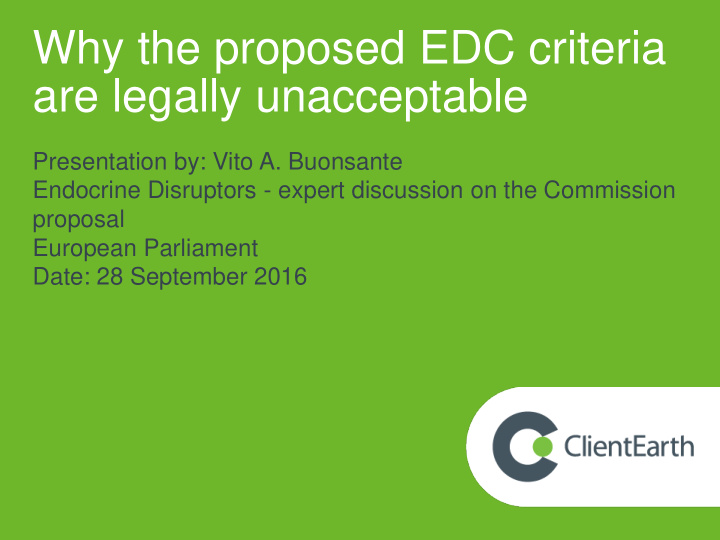



Why the proposed EDC criteria are legally unacceptable Presentation by: Vito A. Buonsante Endocrine Disruptors - expert discussion on the Commission proposal European Parliament Date: 28 September 2016
Contents • Introduction to ClientEarth • Does the EU care about endocrine disruptors? • Hazard based criteria – risk based regulation • Legal assessment of the criteria • Assessment of change in risk management approach
Introduction to ClientEarth • ClientEarth is a non-profit environmental law organisation • We use law, science and policy to tackle key environmental challenges • We work on climate change, energy, environmental justice, biodiversity, forests and human health
The EU cares about endocrine disruptors • Water Framework Directive (2000) • REACH (2007) • Cosmetics (2009) • Plant Protection Products (pesticides) (2009) • Biocides (2011) • 7 th Environment Action Programme (2013) • Medical devices (2016)
Hazard based vs risk based
EU regulation always risk based
High level of protection • Both the Biocides and Pesticides Regulations: • Aim at ensuring a high level of protection for human health and the environment; • Are underpinned by the precautionary principle. • Article 191(2) Lisbon Treaty: • Union policy on the environment shall aim at a high level of protection […] It shall be based on the precautionary principle and on the principles that preventive action should be taken […]
Introduction to ClientEarth • ClientEarth is a non-profit environmental law organisation • We use law, science and policy to tackle key environmental challenges • We work on climate change, energy, environmental justice, biodiversity, forests and human health
Main findings [Criteria] • The scientific criteria need to be based solely on hazard identification (no exposure considerations) • The same approval mechanism for ED as for substances that meet the CMR classification criteria • The approval mechanisms for active substances are applicable both to substances known and presumed to have endocrine disruptive properties • The scientific criteria, too, need to reflect the precautionary principle
Hazard based criteria The scientific criteria set out by the drafts are in all likelihood* based on scientific considerations exclusively. In particular, they are based on hazard identification. * See Point 2.(3)(a)(iii) of COM proposal
Equivalent level of concern to CMRs • The Biocides and Pesticides Regulations provide for the same regulatory mechanism for EDCs as it does for CMR classified or classifiable according to CLP. • It can be followed that in order to ensure a high level of protection the co-legislators attribute to ED an equivalent level of concern as they attribute to CMR substances.
Known and presumed • Limiting the identification to “known” and not to “presumed” EDCs is contrary to the objectives and the systematic context of the biocides and the pesticides; • Therefore the criteria exceed the objectives, content and scope of the powers mandated to the Commission by the basic acts.
Approval mechanism for pesticides The derogation mechanism based on negligible exposure would be substitutes by a mechanism based on a specific risk assessment which would allow non- negligible exposure as long as the risk assessment concludes that the identified risk is sufficiently low
Original text
Commission proposal
Legal basis • The change is based on Art. 78(1)(a) PPPR which allows changes of non-essential elements taking into account current technical and scientific knowledge. • Changes in risk management are not a technical decision, but a political one and affect an essential element of the Regulation
Conclusions • The Commission proposal exceeds its powers as it changes essential elements of the regulation • The Commission ignores the fact that the legislator places an equivalent level of concern to CMR for ED substances • The proposal fails to protect human health and the environment and is not precautionary
Thank you Vito A. Buonsante vbuonsante@clientearth.org www.clientearth.org @ClientEarth @fuori_fuoco
Recommend
More recommend